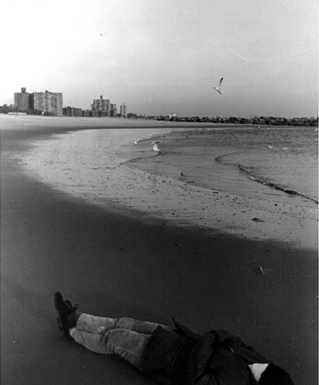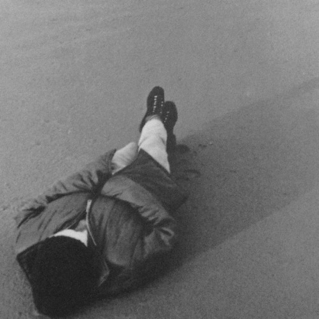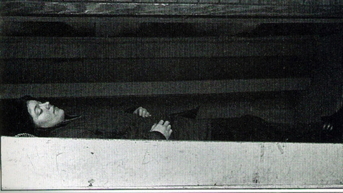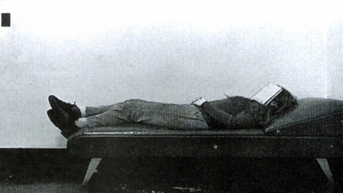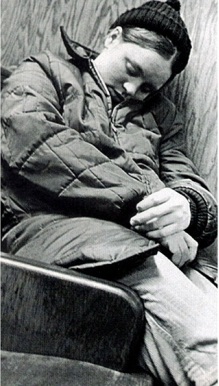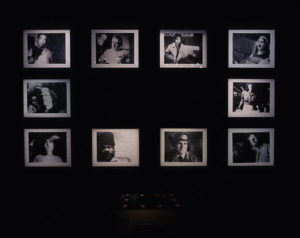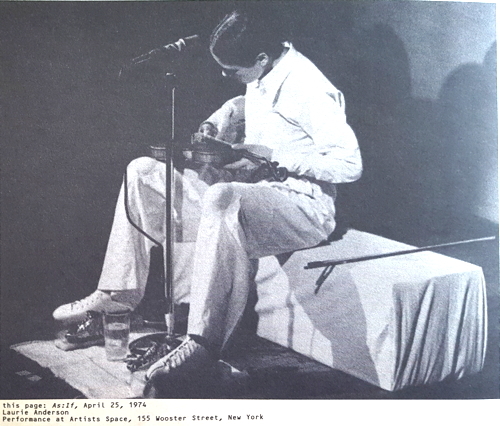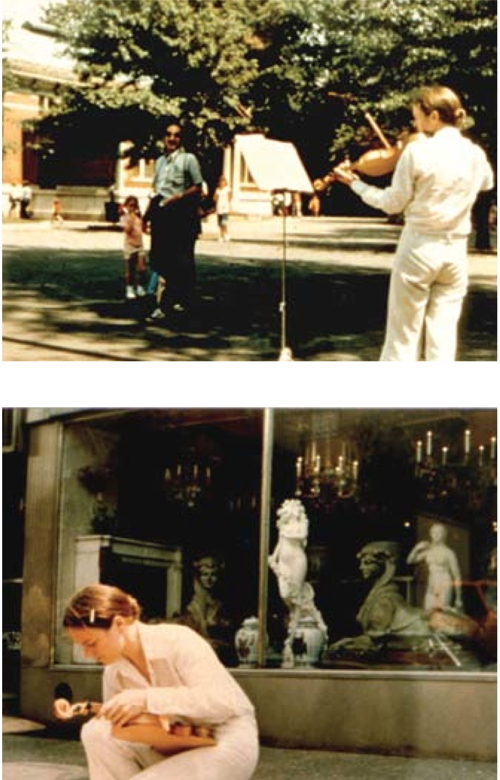listening, auditoria, audiences / écoute, auditeurs, auditoriums : — Studies —
AUDITORIAétude / studyEARLY WORKS (LAURIE ANDERSON)
|
|
Cette série explore les œuvres prenant la notion d'auditorium comme principe / This series is a study about works based on principles of auditoria. • COMPOSING THE NOW (Michel Waisvisz) - 2003 — read /lire • JULES VERNE - (Auditoires, Noise et Aventures Acoustiques / ''Audiences, Noise and Acoustic Adventures'') - XIX° — read /lire • BREATH (Gerald Shapiro) - 1971— read /lire • THE HANDPHONE TABLE (Laurie Anderson) - 1978— read /lire • LAURIE ANDERSON (Early Works 1971-1978)— read /lire • SIX SOUND PROBLEMS (Bruce Nauman) - 1968— read /lire |
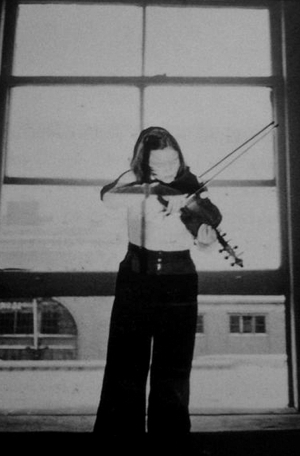
|
Page : — — [Introduction (in French)]
Pages : — — [The Handphone Table (1978)] — [Part 1 : 1971-1972] — [Part 2 : 1973-1974] — [Part 3 : 1975-1976] — [Part 4 : 1977-1978] — [Part 5 : 1979] —
Part 2 - 1973-1974 |
- ► 1973
- ► 1974
- ► 1974 — exhibition at Artists Space, NYC
- ► 1974 — AS : IF, performance, Artists Space, NYC
- ► 1974 — Dearreader (How to Turn a Book Into a Movie)
- ► 1974 — In the Nick of Time
- ► 1974 — Self-Playing Violin
- ► 1974 — How to Yodel
- ► 1974-75 — Duets on Ice
- ► 1974-1975 — Songs & Stories for the Insomniac
- ► Next Part 3 : 1975-1976
1973(Edit)
| -Took sculpture classes with Sol Lewitt and Carl Andre at the School of Visual Arts -Made a series of talking boxes on stilts -Walked around Rome for two weeks with Sol Lewitt -Met Vito Acconci and was struck by the intense emotion in his performance -Met Phil Glass; joined other artists who sat in on Phil's rehearsals which resembled meditation exercises -Wrote TRANSPORTATION TRANSPORTATION |
1973 — O-Range(Edit)
| Dix performeurs avec un mégaphone crient des histoires différentes à travers un grand stade vide. |
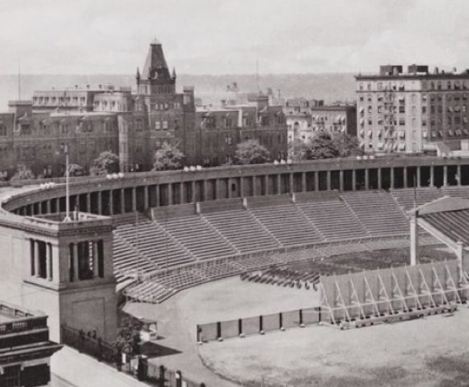 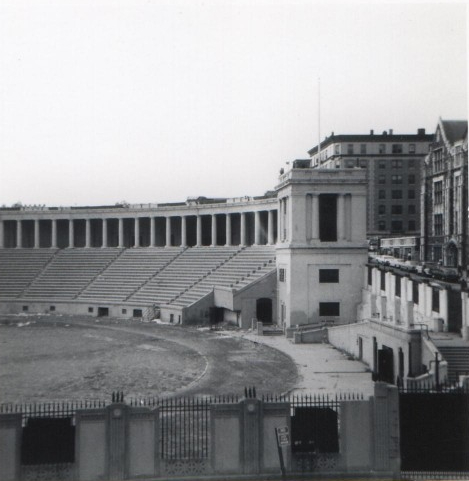 | Town Green, 1973 Lewisohn Stadium, City College of the City University of New York, 1973 sponsored by Vito Acconci — — "Megaphones were used as the sound system in a large empty sports stadium [ — the Lewisohn Stadium of the City University of New York on 138th Street and Amsterdam Avenue, a large amphitheater demolished only a few months later]; ten performers [Anderson’s students] shouted stories across the field." — (Laurie Anderson) — — As with the Town Green in Rochester [the Automotive performance], listening was inscribed in the history and architecture of the Stadium, which boasted a history of large-scale musical performances for audiences of thousands between 1918 and 1966. The New York Philharmonic’s program from 26 June 1935 presents a representative medley of pieces: the prelude to Richard Wagner’s Die Meistersinger is followed by Beethoven’s Symphony No. 5, Felix Mendelssohn’s Concerto for Violin and Orchestra in E minor, and Three Dances from the ballet The Three-Cornered Hat by Manuel De Falla. Another typical program, from 1956, opens with directions “in the event of air raid alarm” and features the Stadium Symphony Orchestra in an all-Gershwin evening starring soprano Leontyne Price. O-Range positions the megaphone – and the amphitheater, for that matter – not so much as a musical instrument and more as a technology establishing a listening relationship, commanding attention, and creating a sense of emergency. [...] The conventional function of the car horn and the megaphone as sound technologies of alarm is unsettled by the faux-classical style of Automotive and the feminized storytelling of O-Range. — (In Lucie Vágnerová, Sirens/Cyborgs: Sound Technologies and the Musical Body, Thesis Submitted in partial fulfillment of the requirements for the degree of Doctor of Philosophy in the Graduate School of Arts and Sciences, Columbia University, 2016) — — Artists Space, then located at 155 Wooster Street, presented her debut NYC show O-Range, titled the same, in 1973 [or in January 1974 ? : Laurie Anderson, Don Gummer, Barbara Kruger January 5 – 26, 1974] and [see below]), for which she was chosen by downtown fixture Vito Acconci for the Artists Select Artists series. For the exhibition, she showed works that paired text and photography in the conceptual style-du-jour with tongue-in-cheek plays on language and food : unframed panels featuring handwritten texts, and black and white photos in a documentation style. |
1972-73 — Institutional Dream Series(Edit)
| Laurie Anderson qui s'intéresse aux rêves s'installe sur une plage ou un quai de métro, bien fatiguée, pour voir si les siens ont un rapport avec le lieu public où elle s'endort. — — En 1973, elle avait fait le pari que ses rêves seraient influencés, conduits et colorés par l’esprit des lieux dans lesquels elle choisirait de s’endormir (« 8 rêves institutionnels »). Alléger la cartographie pour toucher au plus vrai, sans conclure de pacte avec la vraisemblance ! En ce sens l’œuvre de Laurie Anderson à plus à voir avec Cervantès qu’avec Sony. — Thierry Raspail - Source : http://archive.grame.fr/Biennale/MES2002/laurie.html ) |
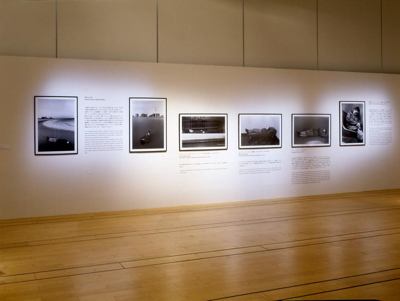 | A personal study of narcolepsy and dreams In this performance Laurie Anderson slept in various public places to see if the place would affect her dreams. She chose places like public bathrooms, a park bench and the public library. Institutional Dreams, took place across New York City, including at 100 Centre Street and the South Street Seaport in Lower Manhattan. For this series, Anderson would sleep in public sites, from Columbia University to Coney Island, as an experiment in gauging “if the place can color or control my dreams.” At the night court of 100 Centre Street, Anderson slept in one of the pews and was photographed doing so by her friend Geraldine Pontius. Her handwritten note that accompanies the slouched, sleeping portraits. Anderson notes that her dreamscape was influenced by her peaked knit cap, which alternately obscured and shown the courtroom’s light onto her face; her impressions distinctly affected by the environment in which she positioned herself. Anderson’s rather routine dream descriptions for Institutional Dreams have a resonant charge in their specific connection to impressions of place and the way they distinctly frame her memories and sensations, on both a conscious and subconscious level. Similar references to dreaming and dream states continue throughout Anderson’s work, in both her song lyrics and performances. — Source : http://lmcc.net/place/creative-insiders-laurie-anderson/ |
| The Institutional Dream Series, and that started out by falling in sleep in art history class, and having these dreams that were personal things mixed with the images that were on the wall in a very strange way. And so I got interested in how that mix occurs, and what influence the place that you are in has on your dreams. So, at any rate, I went to about eight different places to sleep: institutional, like night court, bureau of immigration and naturalization. By doing it I learned a couple of things actually. One was that sleeping is definitely; public sleeping anyway, is a real taboo. Also I had a friend who came to take photographs of the places, and we were kicked out of night court because of the camera. People thought that they were going to be blackmailed, that we would show these photographs and take them to their bosses…” You know who is in the night courts…” The judge broke the camera. Well first he unrolled all the film, then he just dropped it like that. He said, “No cameras in the court, you knew that.” I realized then that you had to go to this real strange middle route between seeing too much, I mean the way a camera does, and not seeing anything like when you’re asleep. You had to have a certain kind of glazed look on your face one way or another, you know, seeing too much or seeing nothing. I was interested in working with cameras and sort of street situations, too; I mean taking photographs of anyone who would say anything to me. Yeah, and also I was working at the time as an art reviewer-reporter [for a series of different magazines, first for Art News, Art in America, Art Forum]. — (Laurie Anderson, Interview by Kate Horsfield and Lyn Blumenthal, 1977, published Apr. 2006, Fnews, The School of the Art Institute of Chicago) |
1973 — Fully Automated Nikon (Object/Objection/Objectivity)(Edit)
| — — First shown at the Harold Rivkin Gallery, Washington D.C., 1973 |
| Laurie Anderson, en 1973, à 26 ans, est l’objet de commentaires plus ou moins obscènes d’hommes, jeunes et vieux, dans les rues de la Lower East Side (« Wanna fuck ? »). Aussitôt, systématiquement, elle s’arrête et les prend en photo : la situation est renversée, le chasseur devient chassé. On la craint, on la prend pour une policière en civil, elle demande l’autorisation de conserver la photo et d’en faire d’autres, les hommes s’excusent ou nient l’avoir insultée (comme si c’était de la ventriloquie, dit-elle). Elle dissimule leur identité avec une barre blanche sur le tirage définitif, et présente la série Fully Automated Nikon (Object / Objection / Objectivity) avec, pour chaque photo, un petit texte explicatif. L’appareil photo est une arme (comme pour Francis Alÿs) et un bouclier ; l’objet (sexuel, du désir) a soulevé une objection et la relation ainsi crée avec le ‘sujet’, si elle n’est pas nécessairement objective, ouvre en tout cas des voies de réflexion intéressantes. |
| — — An artist leaves her studio. She is Laurie Anderson. In the course of a day in June 1973, she takes photographs of the ten men who accost her in the street with what she terms "unsolicited comments of the 'hey, baby' type." She asks permission first. Her accosters are mostly pleased and flattered to comply. She answers their pleasure with banter, smiles, and laughter ; does her compliance facilitate the easy, close-up portraits she is able to secure? Later in her studio, she responds to her accosters differently, as if now to undermine their ease; like an investigative reporter preparing an evidential dossier, and mindful of the law, she imposes anonymity on her informants: a wedge of white neatly cuts off their eyes. In this case the gesture seems less protective than offensive; in the name of privacy she inflicts blindness, even a kind of objecthood, on subjects who had started out by treating her that way. — (Anne M. Wagner, Performance, Video, and the Rhetoric of Presence, In October 91 (Massachusetts Institute of Technology), Winter 2000, pp. 59-80) |
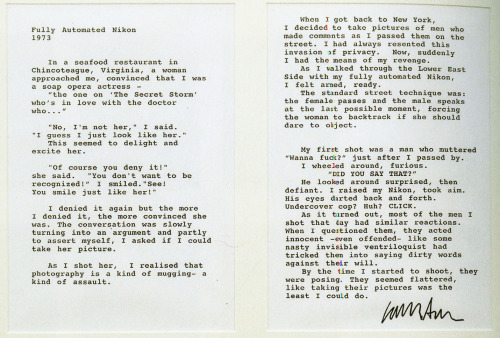 | |||||||||||||||||||||||||||||||
 | |||||||||||||||||||||||||||||||
 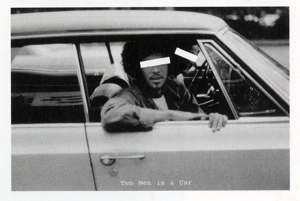 | |||||||||||||||||||||||||||||||
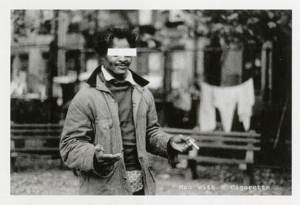 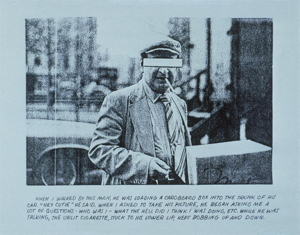 | |||||||||||||||||||||||||||||||
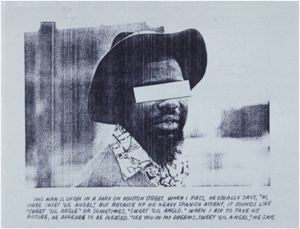 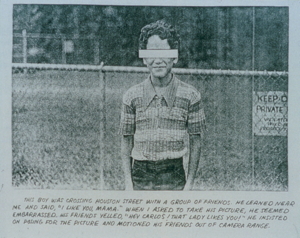 | |||||||||||||||||||||||||||||||
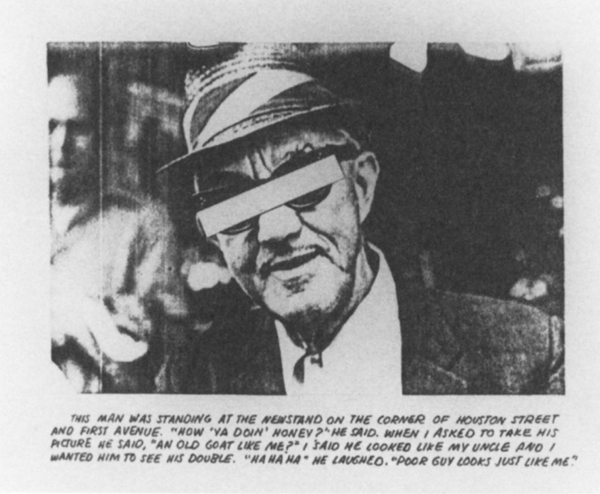 |
a later reference : Dark Dogs, American Dreams (1980)(Edit)
1974(Edit)
| -Received a CAPS (Creative Artists Public Service Program) grant -Lived in Chiapas, Mexico -Hitchhiked to the North Pole -My loft was broken into and almost all my possessions were destroyed -Wrote LIGHT IN AUGUST and THE ROSE AND THE STONE -Joined the Holly Solomon Gallery |
LIGHT IN AUGUST (1974-2002) Light in August [a study, page 1], [a study, page2 was originally published as a set of three books. In the summer of 1974, a thief broke into Anderson's loft, and stole or destroyed nearly all of her possessions. Stricken with grief, she found solace in Albrecht Durer's Melencolia I, using the 16th century engraving to illustrate her list of missing treasures. In Light in August, Laurie Anderson lists the items involved in the 1974 break-in, corresponding each item to an image highlighted in red in a reproduction of Durer's Melencolia I. Things that have been stolen, destroyed, or left behind are assigned a new identity within the framework of the engraving. The original work was displayed in an actual book, with a different image on each page, and its corresponding item beside it. |
THE ROSE AND THE STONE (1974) Laurie Anderson decided, rather intuitively, to hitch-hike to the North Pole and subsequently wrote the book, The Rose and the Stone about the journey. |
1974 — exhibition at Artists Space, NYC(Edit)
| Laurie Anderson, Don Gummer, Barbara Kruger January 5 – 26, 1974 — [Source] 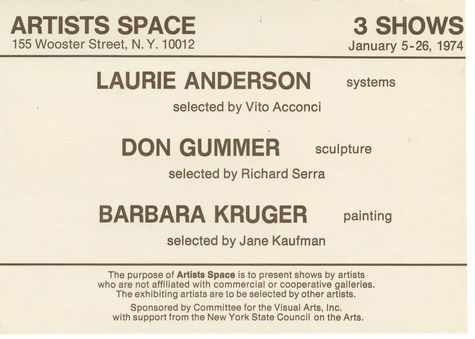  (Claudia Gould, Whirlwind : Conversations with Laurie Anderson, In booklet Artists Space, 25 years, Number 1, Volume 5, Laurie Anderson "Whirlwind", Sept-Nov 1998, page 3) |
What Laurie Anderson wants to do is no less than a redefinition of solo performance and, perhaps, of how we look at our world. From ensemble work, encompassing musicians, lighting directors, engineers, projectionists and other technicians. — (In Ear, Volume 13, New Wilderness Foundation, 1988) |
1974 — AS : IF, performance, Artists Space, NYC(Edit)
| — — April 23 – 26, 1974 — PersonA, collective exhibition, A video and performance series focusing on autobiography, Curated by Edit DeAk, editor of Art-Rite. Encouraged by Vito Acconci, Laurie Anderson attempted to structurally blend different personal stories with oversized projections of words in As:If (subtitled Tales from the Vienna Wood ?). Anderson’s performance As:If (1974) explores the body of the voice from the image of the voice by combining visual projections, audiotape, autobiographical storytelling, and the playing of a water-filled violin. Anderson, dressed in white and wearing ice skates embedded in blocks of ice and a sponge cross around her neck, sits in front of a large slide projection screen onto which images of sets of words appear. Speaking of family, religion, memory, and language, Anderson’s monologue accompanies slide images of words, sounds of phrases from a prerecorded tape and of her altered violin — (In Johanna Frank (University of Windsor), Exposed Ventriloquism: Performance, Voice, and the Rupture of the Visible, Ann Arbor, MI: MPublishing, University of Michigan Library, vol. 19, Fall 2005-Spring 2006, Issue title: Bodies: Physical and Abstract — — See also : Jean-François Caro & Camille Pageard, «Welcome to PAP, Public Access Poetry»). On one side of the screen was a word concerned with language, and on the other, separated by a colon, was a word related to water (for example : SOUND : DROWN). In the performance, Laurie Anderson undertakes a de-construction of the feeling of a present self through the launching of a technological device. In a similar way to the development of a minimal music process, Anderson superimposes with a slight lag a sentence pronounced by a live performer with the same sentence registered and reproduced by a recording tape. “The real” time and the time of the record are overlapped, leading to a dislocation of the present time through its echo and, consequently, to a de-centering of the meaning of the sentence. — (In Ainhoa Kaiero Claver, Technological fiction, recorded time and 'replicants' in the concerts of Laurie Anderson, TRANS, nr14, Revista Transcultural de Mùsica, 2010) |
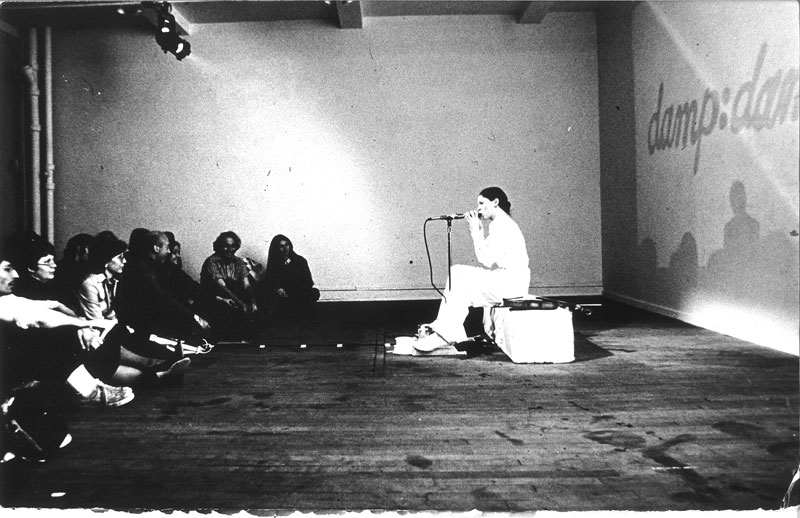 As If, A performance by Laurie Anderson, April 25, 1974 - Exhibition PersonA, organized by Edit DeAk, Artists Space, NYC |
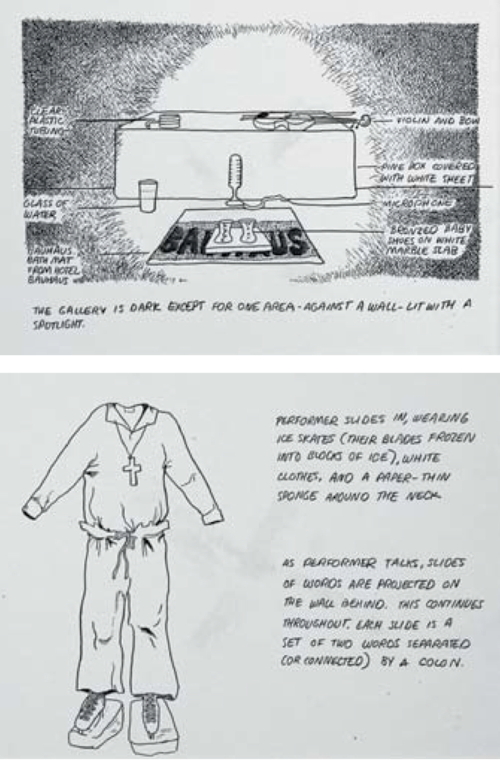 Sketches for As : If performance 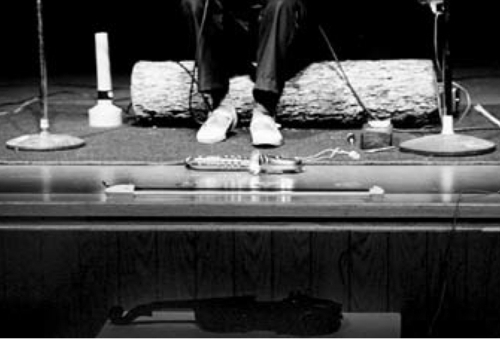 Re-enactment of the As : If performance Re-enactment of the As : If performance | Clear plastic tubing Glass of Water Bauhaus bath mat from Hotel Bauhaus Violin and bow Pine box covered with white sheet Microphone Bronzed baby shoes on white marble slab The gallery is dark except for one area - against a wall - lit with a spotlight. Performer slides in, wearing ice skates (their blades frozen into blocks of ice), white clothes, and a paper - thin sponge around the neck. As performer talks, slides of words are projected on the wall behind. This continues throughout. Each slide is a set of two words separated (or connected) by a colon. I first performed as Artists Space in 1974, a few months after my exhibition. In the performance, called As : If, I wore all white. The dress functioned as a kind of film screen, upon which images were projected. In early performances like that one, I was interested in the use of one basic form — in As : If it was an arc. Most of the basic shapes are derived from forms near where I live. […] On the evening I performed As : If, I was nervous about whether the microphone I had strapped under my right underarm with an improvised mike-clip would fall out. It really looked ridiculous but I gave it a try. I wanted to have my hands free to do other things. This was before reliable remote wireless microphones. At that time, I did a multimedia show, which meant I used slide projectors, Super-8 film, big cables, and microphones strapped with a belt to my chest. I wasn’t that nervous at Artists Space, probably because I’d done so much public performing when I was younger. As a kid, I used to perform in front of people for the Talented Teens, USA group. I was a dorky American teenager from Illinois, but here I was doing shows for people like the mayor of Brighton, England, or for U.S. sailors on a ship in Nice, France. I would give chalk talks which meant I’d draw really fast on huge pieces of paper on a specific topic, such as American life. Because I was at cartoons, I would ask someone from the audience to come up and I would do caricatures of them while we talked. That was the entertainment - and it was really fun. So, during the Artists Space show in 1974, I felt more vulnerable than nervous. I kept asking myself, why am I saying all these things about my life and my grandmother ! It was a very unusual thing to do then. There was no such thing as autobiographical art, which is what it was called a few years later. —(Laurie Anderson, Whirlwind, conversations with Laurie Anderson by Claudia Gould) |
| William Duckworth : When did you open the violin case again ? —— Laurie Anderson : 1974 William Duckworth : What kinds of things did you do with it ? — — Laurie Anderson : Anything but play it. I filled it with water and tried to play it. I didn't use it as an actual instrument. It may have been 1976 that I started recording with it. [...] As : If was a series of stories, and the metaphor was always water-frozen or in liquid form. The stories were very personal, about my own memories. I was working with tape for the first time, and with cheap equipment I would find on Canal Street. So that was the origin of it. The first time I did this, I used a small speaker that I put in my loft and changed the volume and pitch of things. That was the first time I used film, slides, tape, action, and stories. And I realized that that was what I really wanted to do. — (Laurie Anderson, interviewed by William Duckworth) |
 (Claudia Gould, Whirlwind : Conversations with Laurie Anderson, In booklet Artists Space, 25 years, Number 1, Volume 5, Laurie Anderson "Whirlwind", Sept-Nov 1998, page 3) |
| — — [My first performance] was called As: if. It was pretty strange. It was the first time I began using a violin in a performance. I mean I used it totally as a prop; it wasn’t really for its musical possibilities. Anyway, in this first performance, I was for some reason wearing these ice-skates with their blades frozen into these blocks of ice which I did again in a street thing…a series of street concerts. But this As: if thing was based on audiotape more than anything actually. The only thing that was visual were words, very large words on slides. They were sets of words with colons. I was really interested in the “is like” sort of syndrome. I was very depressed at the time about most of my thoughts being based on that premise, that something is like something else. Is like is like unto infinity. They’re parallel sets of…equations, and there weren’t really any conclusions. As far as I could see, that was the basis of most art at the time, you know: one thing was like another. So it was interesting to me. It was just doubling up on things. I was trying to work with that, I mean, just the whole system of metaphors. So there were things like different audio layers of sound, that was another part of this thing. The piece was sort of broken down into stories, sort of personal stories that served as examples for these parallel sets of information. One of them was that a year before that, I was in this situation of living in an apartment, and my roommate was going out with a person that I really liked a lot, and I wanted to try and take him away from her. So they would come in and go to her room and lock the door, and then I’d get the violin and just go into the living-room which was right next to their bedroom, and play Tchaikovsky next to the door… architecturally — the architectural thing seems to have been coming up in the work constantly — but in this particular story for instance there are things about sound and about sound sources. For instance, the way you might imagine a Tchaikovsky violin concerto played by Oistrak in quad ; and second, the way that you happen to play it ; the third, the way it sounds coming though the door. Question : Where were you getting the sounds? Were you collecting them from the environment, or were you making them electronically ? — — I had a duck caller and also at that point I wasn’t real involved with audiotapes. It was mostly whatever sound I could make at the time. In the performance after that one I used a violin that I’d just taken apart and put a speaker inside, and so it was itself playing and also its strings went up to a little cassette recorder. Question : So the visual part of that was that it looked like you were playing the violin but the sound was coming from another source ? — — The sound was coming from inside the violin, but it was kind of ventriloquism, violin ventriloquism. There were duets, so that half the sound was on tape coming from the same source. I would take the bow off while it was still going, so in instruments like that there are series of different kinds of ways of changing voice. I work a lot with Bob Alecke who is an electronics designer. Question : The two of you worked together in the technical aspect of the performance ? — — Right, and he designs very incredible things. I just had wanted a piece of equipment so that I could use the sound of a violin instead of voice but still articulate words, which is actually…has a lot in common with wa-wa and rock music, too. In this case, it was a very powerful driver and the sound of the violin was coming through a tube that you put in your mouth, and then the phrasing and the pitch and everything else is violin but the articulation in the mouth is speech. I was interested in deafness at the time actually, and what happens with it… I think I had just heard about Milton going blind, and how his daughters read to him all his favorite things in Homer, but they didn’t know any Greek or Latin, so they read it completely phonetically. You could imagine what it sounded like, “ah uh ah,” all of Homer completely in a monotone. I was using the kind of flatness that he was already in and so a lot of the sound work that I did at the time involved the difference between speaking and sort of understanding phonetics. Question : Seeing where sound comes from, hearing where sound comes from. — — Yeah, right, and also the dynamics of learning about sound. I had been on an Indian reservation, at a place in Canada. There was a place called Corner Restaurant, and there were no corners on the reservation and no streets, you know. But it’s one of those adapted sort of things, and in the restaurant there was a jukebox and in the jukebox there was only one record which was one that was popular at the time, George McCrae’s “Rock Your Baby.” The Cree kids knew the song completely but with the weirdest kind of phrasing. They just learned it right off the record. I got real interested in that kind of tension between parodying something and swinging with it, so I made a film about that actually, about that jukebox, which is an animated crossword puzzle of various ways of spelling the lyrics to that song and the way they would leak into other meanings, like “Rock you, rock you”… so that the sound itself became very non-specific and it could be plugged into any number of meanings. The soundtrack for that was using this violin voice thing so that is was a kind of parallel situation of enunciated things with the tone coming from somewhere else. That particular way of using sound is a lot like the things I’ve been working with recently, the tape-bow violin, which is an instrument that has an audio head mounted on the body of the violin. — (Laurie Anderson, Interview by Kate Horsfield and Lyn Blumenthal, 1977, published Apr. 2006, Fnews, The School of the Art Institute of Chicago) |
1974 — Dearreader (How to Turn a Book Into a Movie)(Edit)
| — — (Dearreader / Film Talk), Holly Solomon Gallery, New York, 1975 — — (Dearreader-2), Sarah Lawrence College, Bronxville, NYC, 1975 — — (Dearreader-3), Rhode Island School of Design, Providence, R.I., 1975 — — Whitney Museum of American Art, Dec 11, 1975 - Jan 7, 1976 - Autogeography programme : Dearreader'', 1975, Super 8mm film, 45 minutes |
 In Dearreader (1975), Laurie Anderson showed a series of photographs coupled with texts at the Holly Solomon Gallery in New York. — Dearreader, a film from 1975-82, uses the conventions of 1940s film noir to comment on the antiquated but still pervasive sexual stereotypes of the mass media. Anderson begins Dearreader with a portrayal of a love-scene in the style of a ’40s movie, followed by a series of intentionnaly cliched vignettes. : the coupe embrace, a clock chimes, nine pages from a monthly calendar fall to the floor showing the passing of time, a baby cries. In this film-performance of 1974, Laurie Anderson referred to not one but three of here favorite storytellers — eighthteenth-century author Laurence Sterne (to whom the film is dedicated), and Herman Melville, for the manner in which he talked directly to his readers. Anderson called this work a « performance film » or a « talking film », referring to the fact that she performed live on her violin at the beginning and end of the screening. See also : — Songs & Stories for the Insomniac (see below 1974-1975) | Dearreader, Black and white video tape with sound from the super-8 film 23 minutes Dearreader [a film/talk] (1974) — How to turn a book into a movie. Dedicated to Lawrence Sterne —, a film directed by Laurie Anderson and Bob George featuring Geraldine Pontius, was shot in one room and involves nine autobiographical stories read in a voiceover by a female narrator. During the presentation of the film, Anderson plays her violin as a live soundtrack and uses her own voice to speak out loud the dialogue of the film. Voice is both a mediatized representation (the instrumental soundtrack) severed from its source (the film), a representational extension (musical sound) that emerges from the actions of an identified source (the violin playing) and a real albeit amplified production (dialogue) that emerges from an identified source (Anderson’s corporeal body) but does not necessarily correspond with the visual display of the filmic projection. — (In Johanna Frank (University of Windsor), Exposed Ventriloquism: Performance, Voice, and the Rupture of the Visible, Ann Arbor, MI: MPublishing, University of Michigan Library, vol. 19, Fall 2005-Spring 2006, Issue title: Bodies: Physical and Abstract) |
1974 — In the Nick of Time(Edit)
— — — A performance at The Clocktower, NYC, 1974)
In the Nick of Time (1974) posits Anderson’s physical body as that which directly interferes with and constitutes spectacle: Anderson moves in and out of the light of a projector and traces an outline of the projected image on the wall that served as the screen. When the film ends, the red traced object remains on the bare wall and silence engulfs the room. — (In Johanna Frank (University of Windsor), Exposed Ventriloquism: Performance, Voice, and the Rupture of the Visible, Ann Arbor, MI: MPublishing, University of Michigan Library, vol. 19, Fall 2005-Spring 2006, Issue title: Bodies: Physical and Abstract) Anderson uses time to emphasise a structure that regulates an otherwise chaotic world. Images of time In the Nick of Time, in which she played her violin, told her family stories, and recounted her dreams. include clocks and calendars …. — (Gillian Kime, Laurie Anderson as being a 21st Century storyteller within the performing arts, 1999) In Anderson's second extended performance, In the Nick of Time, she developed themes and devices from As:lf Songs from In the Nick of Time include "Click! " — "Don't Lose It Now!" — "Bless This Bran" — "Is Like" — "That Chicken Float As I Lie" — "1976" — "Ya!" — "Old Flames" — "Waiting for You" — "If you were a sport" — "Black Water" — "Hour of Power" |
| — — Well, the next [performance I did with the Tape Bow Violin] was in 1975, called “In the Nick of Time,” the basic premise was really film more than anything else. I was interested in these traffic accidents in Amsterdam. At the time, you had to feel responsible for someone’s death; you’d have to jump out, the cop would give you some chalk, and you’d outline the way the body fell and then come back and paint it in white, and I thought that was really grisly. They stopped doing it pretty quickly because it was just too depressing to see them, these silhouettes. I did like that sort of frozen motion, the way of diagramming motion, and so I did a series of films that were shot from the exact same angle, a completely stationary camera onto a table where there were several objects and a person. For instance, there was in one episode a cereal box in one place; during the performance that rectangle was sprayed red and the film would go on and later, say a book would just slot into that place with the red outline. By the end it was sort of a blackboard diagrammatic thing, just shapes that had been filled with different kinds of objects. I wanted the film to come from various different kinds of sources. So there was one long story about mothers. This film came out of this purse and onto the ceiling. It was like a situation with a lot of rigged objects and then for some reason it was all…instead of water it turned out to be, this is very elemental, a lot about fire. And all sorts of metaphors for burning. [This] early performances actually [was] pretty much based on things that had happened to me in a sort of distant past. — (Laurie Anderson, interview, 1977 — [Source] |
1974 — Self-Playing Violin(Edit)
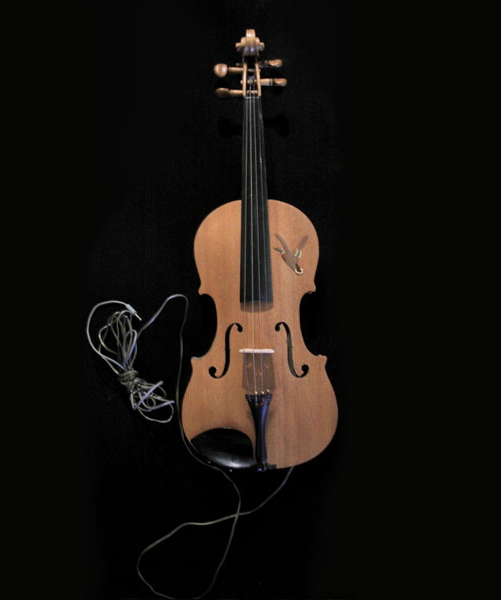 Self-Playing Violin. 1974. Modified violin with built-in speaker and amplifier (sound). 31 min. | (version française ci-dessous : 1974 - How to Yodel) Modified violin with built-in speaker (with internal audio speaker). As early as 1975 in Duets on Ice [see below], a piece in which Anderson performed on the Self-Playing Violin, a violin with a cassette player installed in its body that accompanies her playing, the violin has been integral to her performances. Over the years she developed many violins : — self-playing violin (1974), — viophonograph (1975-1976) (with partnership with audio engineer Bob Bielecki) (a violin mounted on a record turntable that moves the bow), — (See Part 3 - 1975-1976) — tape bow violin (1977) (which she plays by passing a prerecorded audio tape, strung across a bow, over a tape player’s audio heads, which are mounted in place of the violin strings), — (See Part 4 - 1977-1978) — neon violin (1982), — digital violin (1985). — 1978 - Song for Self-Playing Violin, Contemporary Art Center, Cincinnati — 1978 - Song for Self-Playing Violin-2, Real Art Ways, Hartford, Conn. Audio document : in cd The Record Of The Time (Sound In The Work Of Laurie Anderson), Catalog of an exhibition held at the Musée d'art contemporain de Lyon (France), Museum Kunst Palast in Düsseldorf (Germany), Padiglione d'arte contemporanea in Milan (Italy) and other venues in 2002-2003, with a 2-minute recording of the Self-Playing Violin recorded 1974. |
Self Playing Violin (recorded 1974)
from the CD The Record of the Time (Musée D'art Contemporain De Lyon – ISBN 2-096461-57-1), 2002
Catalog of an exhibition held at the Musée d'art contemporain de Lyon (France), Museum Kunst Palast in Düsseldorf (Germany), Padiglione d'arte contemporanea in Milan (Italy) and other venues in 2002-2003.
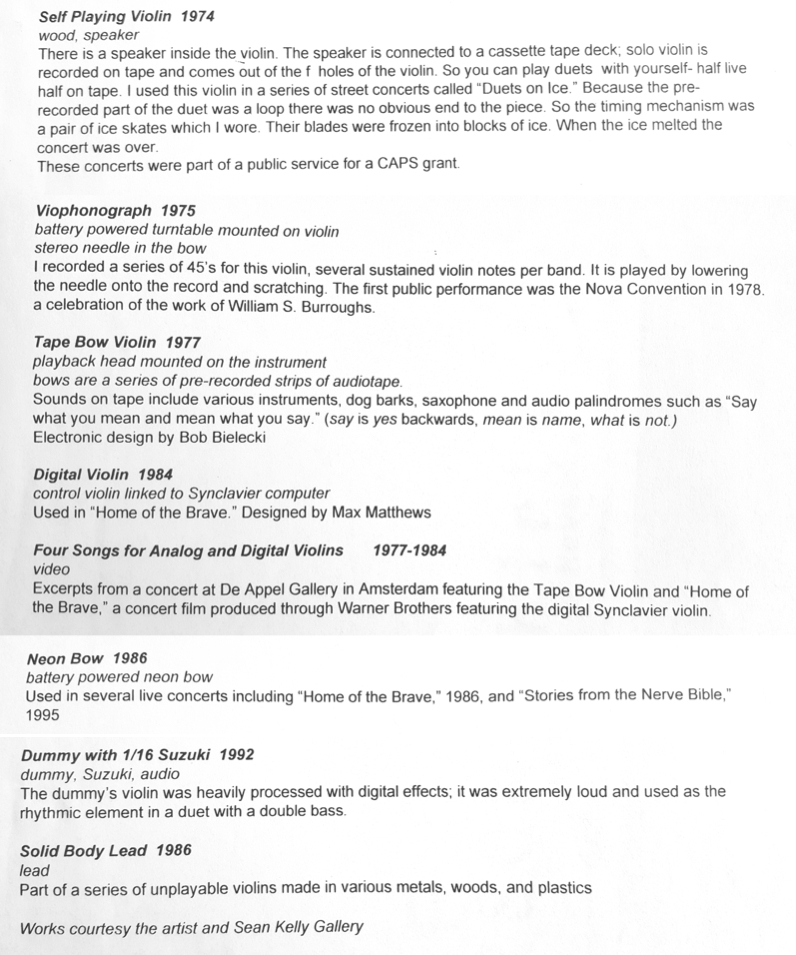 (In Laurie Anderson "Whirlwind", Sept-Nov 1998, Artists Space programme) |
1974 — How to Yodel(Edit)
— — Nov. 30, 1974 — Soup & Tart, organised by Jean Dupuy, The Kitchen, New York
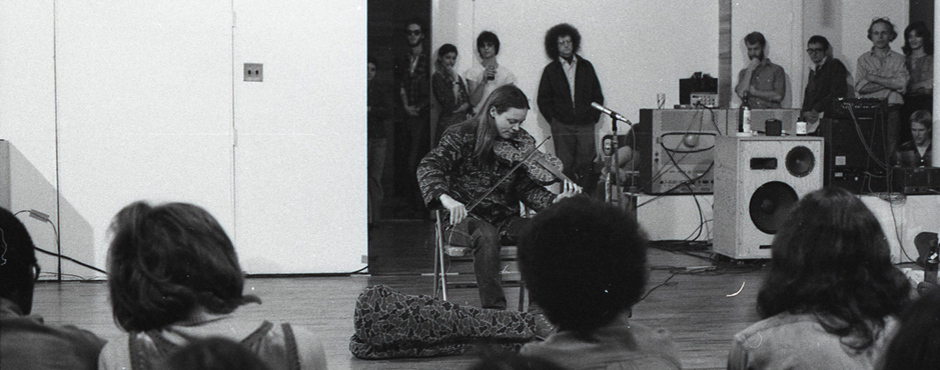 Laurie Anderson performing How to Yodel in Soup and Tart, The Kitchen, New York, 1974 - Photo by Kathy Landman. |
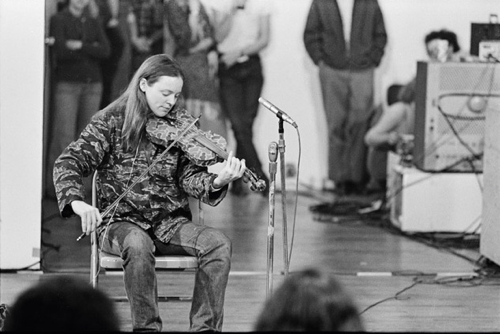 Laurie Anderson performing How to Yodel in Soup and Tart, The Kitchen, New York, 1974 - Photo by Peter Moore. — — — — I’m afraid my memory of Soup & Tart is a little bit foggy… but I know it was the first time I used the Self-Playing Violin. This is a violin with a small speaker inside - and the speaker wire runs to a cassette deck. Half of a violin duet was in tape (coming out of the F holes of the instrument) and the other half was plying simultaneously live. There were words to the song but I don’t remember exactly what they were. Soup & Tart was right after my loft on Second St. had been broken into ; I’d just spent the summer hitchhiking to the North Pole and came back to find a huge hole chopped through the concrete wall of my loft. All my films had been burned - books and clothes ripped up, windows broken, and magic marker messages three feet high on all the walls. This was when I really started camping out - wandering around New York, staying at friends’ places. I remember the camouflage song had something to do with the way I felt to be your own walking house. — (Laurie Anderson, In Jean Dupuy, Collective Consciousness, Art Performances in the Seventies, Edited by Jean Dupuy, Performing Arts Journal Publications, New York, 1980, p.154) 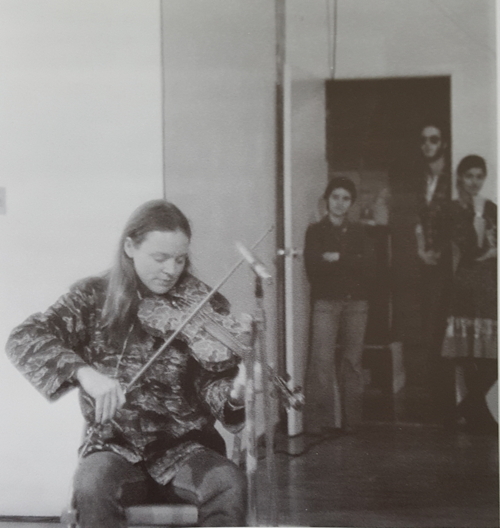 Laurie Anderson performing How to Yodel in Soup and Tart, The Kitchen, New York, 1974, In catalog Jean Dupuy, À la Bonne Heure, Semiose éditions / Villa Tamaris Centre d'Art / Villa Arson Nice, 2008. Download a large picture | — — — Je crains que mes souvenirs de Soup & Tart ne soient un peu vagues… Mais je sais que c’était la première fois que j’utilisais le Self-Playing Violin. Il s’agit d’un violon dans lequel est placée une petite enceinte - l’enceinte est reliée à un magnétophone à cassettes. La moitié du duo de violon est sur cassette (diffusée par les ouïes de l’instrument) et l’autre moitié est jouée simultanément en direct. La chanson avait des paroles mais je ne m’en souviens pas exactement. Soup & Tart a eu lieu juste après le cambriolage de mon loft de Second Street ; je venais de passer l’été à faire du stop jusqu’au Pôle Nord et quand j’étais rentrée, j’avais découvert un énorme trou creusé dans le mur en béton de mon loft. Tous mes films avaient été brûlés - mes livres et mes vêtements étaient déchirés, les fenêtres cassées, des messages d’un mètre barbouillés au feutre sur mes murs. C’est à ce moment-là que j’ai vraiment commencé à faire du camping - j’errais dans New York, je dormais chez des amis. Je me rappelle que cette chanson, sur le thème du camouflage, était en rapport avec ce qu’on ressent, quand on est sa propre maison ambulante. — (Laurie Anderson, In Jean Dupuy catalogue À la Bonne Heure, Semiose éditions / Villa Tamaris Centre d'Art / Villa Arson Nice, 2008, p. 43) — — — — Comme Jean Dupuy habite dans un grand loft, suite à son arrivée de France en 1967 il invite des artistes, des amis, à faire d'autres propositions. L'idée de performances collectives est née. Charlotte Moorman, Nam June Paik, Laurie Anderson, Claes Oldenburg, Charlemagne Palestine, Georges Maciunas, Carolee Schneemann, Joan Jonas, Philip Glass, Olga Adorno, Gordon Matta-Clark, Richard Serra,... vont enchaîner de courtes actions régulées par la durée et parfois par un dispositif imposé (Whitney Museum, Judson Church). À la Kitchen, il organise la soirée Soup and Tart où 40 artistes font une petite pièce n'excédant pas 2 mns. |
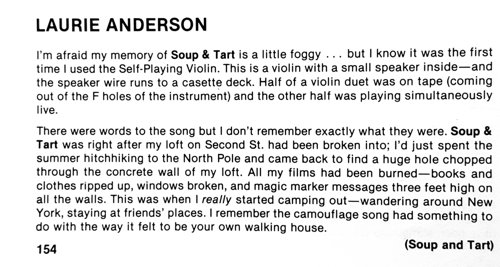 Laurie Anderson about How to Yodel, In Jean Dupuy, Collective Consciousness, Art Performances in the Seventies, Edited by Jean Dupuy, Performing Arts Journal Publications, New York, 1980, p.154 |
1974-75 — Duets on Ice(Edit)
— — 1974 — Five NYC Street locations, New York
— — 1975 — Genoa (Gênes), Italy (Organizzazione Ida Gianelli / Samangallery)
Genoa / Gênes / Genova, Italy, 1975 - Photos by Bob Bielecki.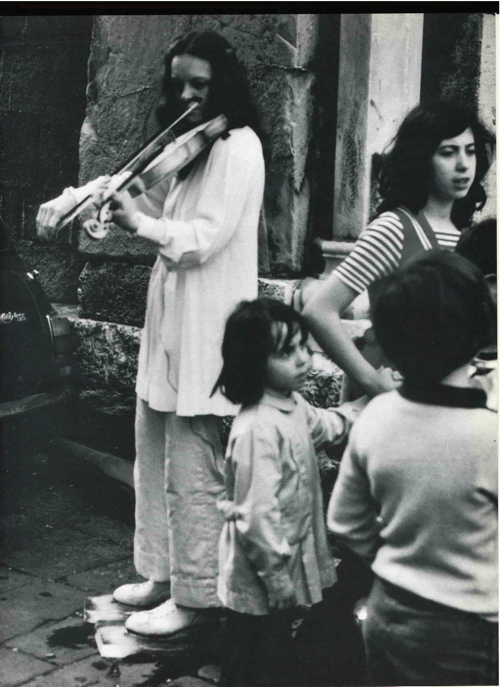 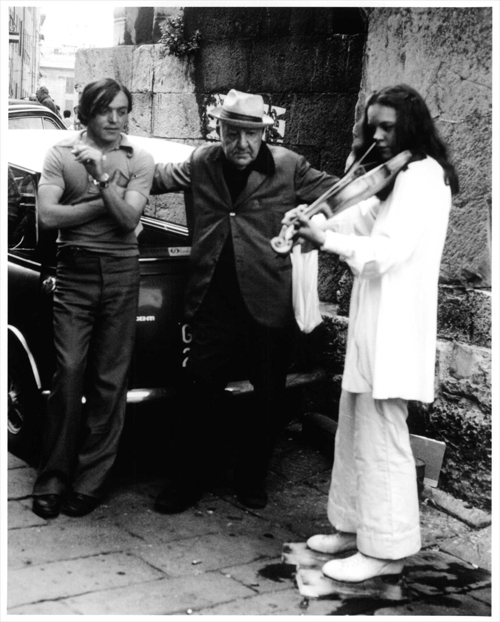 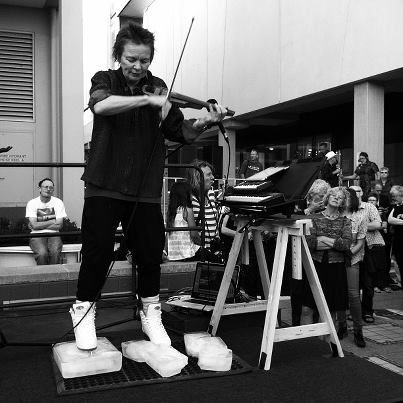 Laurie Anderson performs on ice as part of the Adelaide Festival 2013. Photo by Catherine Zengerer. | 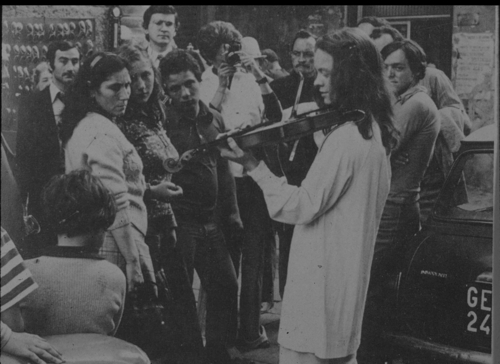 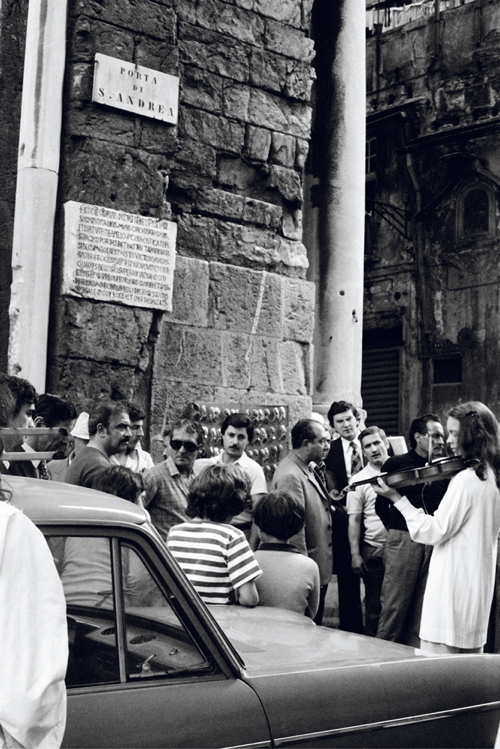 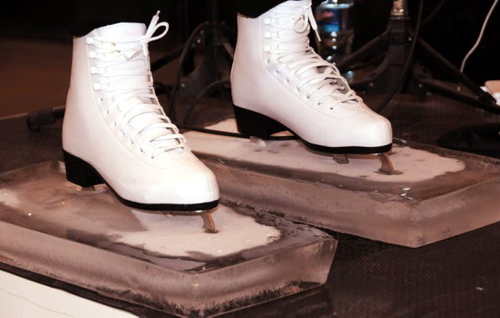 |
1974-1975 — Songs & Stories for the Insomniac(Edit)
— — (1974 — Museum of Contemporary Art, Chicago ?)
— — 1975 — Artists Space, NYC
— — 1975 — (Songs and Stories for the Insomniac... Continued), Oberlin College, Oberlin, Ohio
| Laurie Anderson conjugue la fiction intime à un sens épique de l'histoire. Dans la performance Songs and Stories for the Insomniac (1975), Laurie, vêtue d'une robe blanche traversée par des images vidéo, joue du violon et raconte des histoires personnelles. Ainsi elle interroge l'effet du temps sur la mémoire en puisant dans ses souvenirs personnels. |
| Laurie Anderson appeared dressed with a white screen-dress [or Projection Dress] designed by Patrice George, that serves as the screen for the projection of twelve “film/songs,” while the metronome beats with its regular beat and as she played the violin and told stories, in the performance Songs and stories from the insomniac. Songs & Stories for the Insomniac culminates a series of allusions to Herman Melville during Anderson's career, including Dearreader (see above 1974-1975). Preparing for Songs and Stories, she read Moby-Dick six times (five of the readings in a row). |
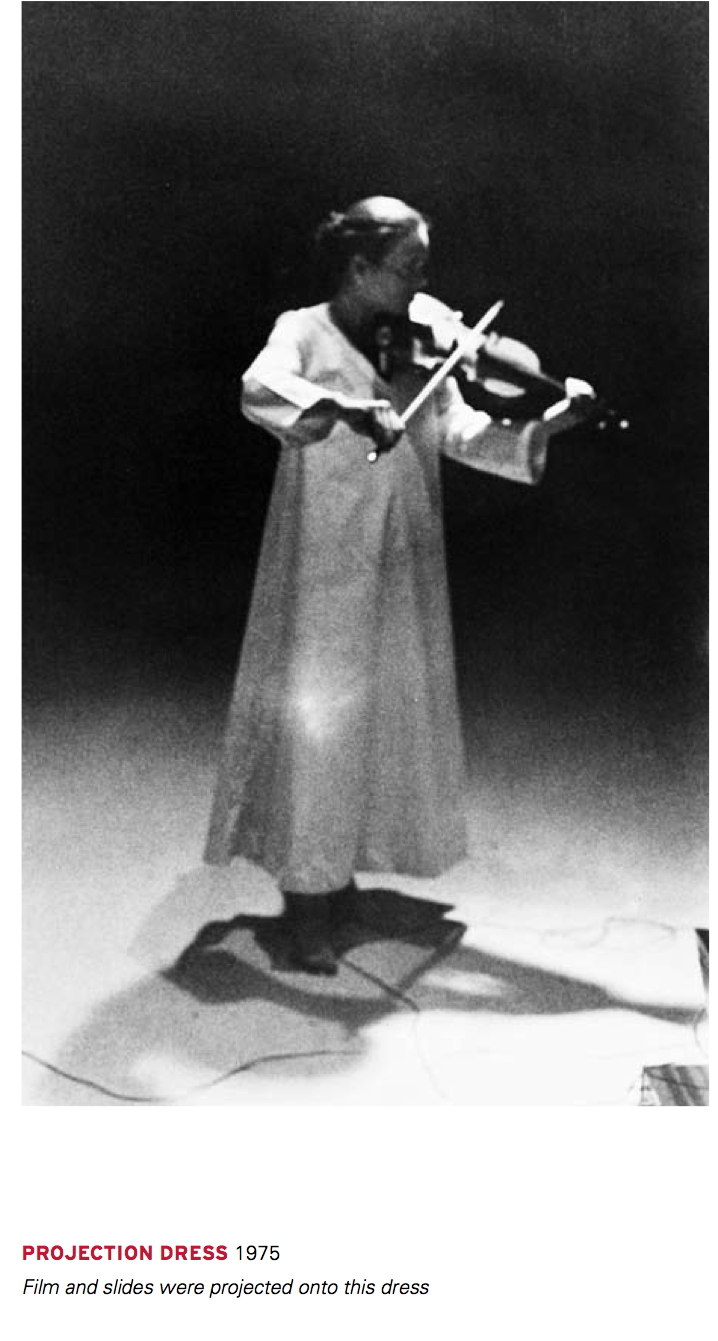
Next Part 3 : 1975-1976(Edit)
Pages : — — [The Handphone Table (1978)] — [Part 1 : 1971-1972] — [Part 2 : 1973-1974] — [Part 3 : 1975-1976] — [Part 4 : 1977-1978] — [Part 5 : 1979] —
Page : — — [Introduction (in French)]
